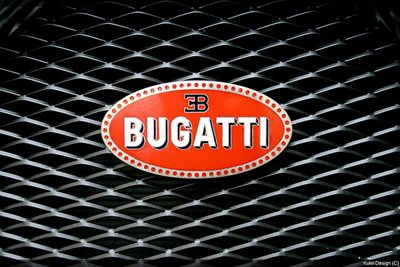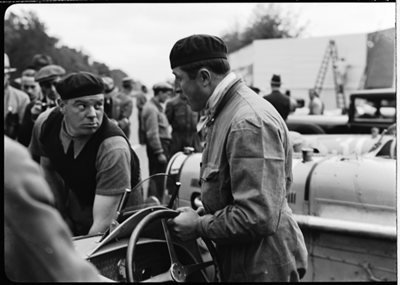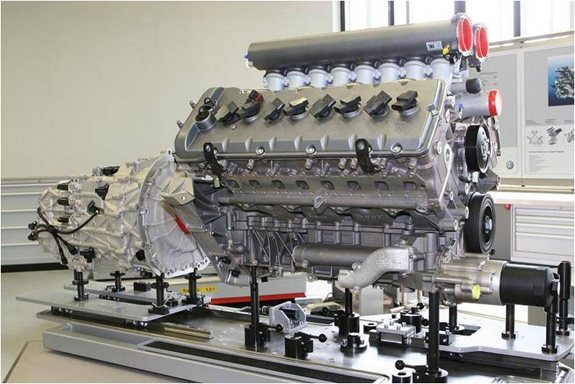| General Info |
|
| Vehicle Type: SuperCar |
Base Price: $1,700,000.00 |
| Fuel Tank Capacity: 25 gal. (94.6 l) |
Miles Per Gallon: 8 city / 13 hwy |
| Dimensions |
|
| Length: 174.2 in. (442 cm) |
Width: 77.9 in. (198 cm) |
| Height: 47 in. (119 cm) |
Curb Weight: 4162 lbs (1888 kg) |
| Performance |
|
| Engine: 8.0L W16-Cylinder, Quad Turbocharger |
Displacement: 7993 cc |
| Horsepower: 1001 HP |
Max RPM: 6000 RPM |
| Torque: 923 lb-ft at 2200-5500 RPM |
Transmission: 7-speed DSG sequential |
| 0-60 mph: 2.5 seconds |
1/4 Mile: 10.2 seconds @ 142.9 mph |
| 0-100 mph: 5.1 seconds |
Maximum Speed: 253 mph (407 km/h) |

The word at the start was that VW had decided to build a toy, a plaything for the rich and would do all they could to make it the ultimate plaything. $1.7bn was spent on the design and build of the car, a cost that at the time VW knew they could not recoup.
The original plan was to build 300 coupes and 150 convertibles that would sell for around $1.5m each leaving a potential billion dollar loss and since Porsche took control of the luxury car division of the VW Group the warning has gone out – ‘No more toys’. Since then we possibly have an indication of the end of the Veyron as the company have announced they will manufacture only a hundred more Grand Sport models down from the 150 previously promised as the market dries up, despite the introduction of this year’s Vitesse model. Bugatti have also moved away from the so-called ‘boutique’ models, where customers could have input into the design and have now moved to production line assembly to cut costs, producing standard model Grand Sports.
So what did the VW get for the massive investment in the vehicle and the potentially huge financial loss they were to make on it? On paper the figures look shocking but when you consider that most car companies spend that amount at least every few years on research and development and prototypes, VW have stretched R & D far into the future in a format they could sell, not just a prototype; the final result being that the car was almost reinvented with many of its components such as had never been seen before but which may pave the way for the future success of VW and Porsche cars.

So what is so special about the workings of the Veyron 16.4? Let’s begin with the name. Pierre Veyron was one half of a duo that won the 1939 Le Mans 24 hour race and who, during the war became a prominent resistance leader who was awarded the Legion d’honneur in 1945 - a heroic man’s name for a heroic vehicle. 16.4 relates to the sixteen valve engine and the 4 to the four turbochargers.
At the drawing board stage, consideration was given to the original ethos of the Bugatti – Ettore Bugatti wasn’t an engineer primarily, he was an artist and he designed his cars foremost as works of art and secondarily to become successful motor cars. The problem with that in the 21
st century is that there are so many truly beautiful cars – a far cry from the early days of motoring when many were designed to look like the horse pulled carriages they were to replace. Instead VW/Bugatti’s design team focused on Ettore’s desire to be different, to recreate the motor car and the best way to do it was to create a super car that would remain literally streets ahead of any competition for the foreseeable future and that meant in the minds of petrol heads - speed and acceleration.
It’s not sure whether VW/Bugatti decided on the speed or the acceleration they were going to create but they knew that the terrifying speeds they needed to create would stretch every inch of their capabilities to ensure the materials and the engineering performed at such high levels of stress and that once the car reached its dizzying top speed, it would keep the driver safe there and enable them to return to rest quickly and safely too. For that reason, many of the design features and materials used may seem completely alien to mere car owners – magnesium, bronze, silver oxide instead of the steel, cast iron and aluminium we’re used to.
Let’s start with the power plant of the car, the eight litre, sixteen valve, quad turbo charged engine. It’s known as the W16 and is based on the VR6, a narrow angle staggered inline six cylinder piston engine. Inline to create a more powerful engine, it would take up too much space under the hood so VW designed the W engine where two engines were ‘fused’ together V to V, hence the W configuration and the four or six cylinders each side giving the engine its specific name of W8 or W12.

The W16 engine used in the Veyron understandably has eight cylinders per side. It manages to be only 28 inches long through the carefully designed configuration with the cylinders now at a ‘bank’ angle of ninety degrees; different to the 72 degree angle of the W8 and W12 engines. Whilst appearing to widen the engine, the configuration allows for only two camshafts per bank, four in total. Despite the use of lightweight materials where possible, the huge power of the engine at nearly 1000 bhp means that it weighs nearly 900lbs, over half the weight of a Smart car. In kilowatts, the car produces 736kW/h and a torque of 922 lbs/ft. It’s thought likely that the Veyron engine could soon become the engine of choice for the Bentley, also produced by VW, as its power would be well suited to the heavy weight of the luxury vehicle.
The transmission of the Veyron also presents us with unfamiliar territory. Operated by a twin clutch, the gearbox can be switched from automatic to electronically controlled semi-automatic but in either mode, the change takes only around 150 milliseconds to complete, virtually no time at all, and it’s this in part that helps the car achieve its phenomenal acceleration. It’s almost like having a twin gearbox for the main transmission unit is located behind the front axle whilst a separate differential unit controls the rear axle in order to equalise the power supplied to each of the wheels. Understandably for safety, the car is in permanent four wheel drive. Another innovative feature of the gearbox is that it doesn’t use a torque converter, unlike mainstream gearboxes. Instead, the system relies on the twin multi-disc clutches which replace the need for the torque converter to set the car in motion. To achieve the low centre of gravity to keep the car on the ground, both the engine and the gearbox run on the dry sump model.
A car that goes as fast as the Veyron needs to be able to stop quickly and safely too and to do so, the designers effectively reinvented the brake system. Out go conventional disks made typically of cast iron and instead the Veyron has silicon carbide discs reinforced with carbon fibre. These are drilled for ventilation and heat transfer and, in tests, perform much more favourably in terms of brake fade than a standard brake disk. The callipers are formed from lightweight aluminium and powered by eight pistons in the front brakes and six in the rear. The force produced by braking at full pressure is equivalent to a maximum to a G-force of 1.3 g whilst 1 g is the standard deceleration force. If the brake system fails, an innovative ABS fitted back up system is available through the handbrake. With such a powerful braking system, the car will slow to a stop from the top speed of 250 mph to zero in under ten seconds but will take up to a third of a mile to do so in good conditions. An additional braking feature is the rear spoiler which, when the brakes are applied, switches to a 55 degree angle adding 0.68 g of brake force.
The body work of the Veyron is composed of lightweight carbon fibre panels and whereas standard steel panels are coated with lead oxide as a rust inhibitor, the Veyron’s panels are given a silver oxide primer, not for rust but as an ultra-smooth surface ready for the body paint. On the Pur Sang model, the silver oxide is left as the colour and simply overcoated with a clear finish. Other models have aluminium panels for aesthetic effect.
The wheels on a Veyron are also quite special. On different models they have a range of construction materials from titanium, carbon fibre, bronze and aluminium alloys. Probably the most beautiful are on the Pur Sang which has high gloss bronze wheels. The tyres cost $25,000 a set and are made specially by Michelin under the PAX brand name. They have to be specially fitted by a garage in France, a service which will set you back another $70,000 including shipping.
Other remarkable features of its build are the ten radiators; three for the intercoolers, three for the engine, one for the air conditioning, one for the front transmission, one for the rear differential and one to cool the engine oil.
All this is mounted on a special carbon fibre tubing chassis, the first of which was sold at auction for charity for an amazing $900,000.